Unilever Report: Value, Organizational Design, and HR Contribution
VerifiedAdded on 2023/01/19
|18
|6679
|41
Report
AI Summary
This report examines Unilever's organizational design, focusing on its structure and how HR contributes to the company's success. It explores the line, matrix, and divisional structures adopted by Unilever, highlighting their advantages and disadvantages. The report delves into organizational design theory, discussing functional, traditional, and contemporary designs and their impact on Unilever's operations. It analyzes the relationship between organizational design and change management, identifying different types of changes affecting the company. The report emphasizes the importance of aligning organizational design with structure and adapting to the dynamic environment. It concludes by summarizing the key findings and their implications for Unilever's continued success in the consumer goods industry. The report uses Unilever as a case study to illustrate how effective organizational design and HR practices can drive organizational goals and objectives.
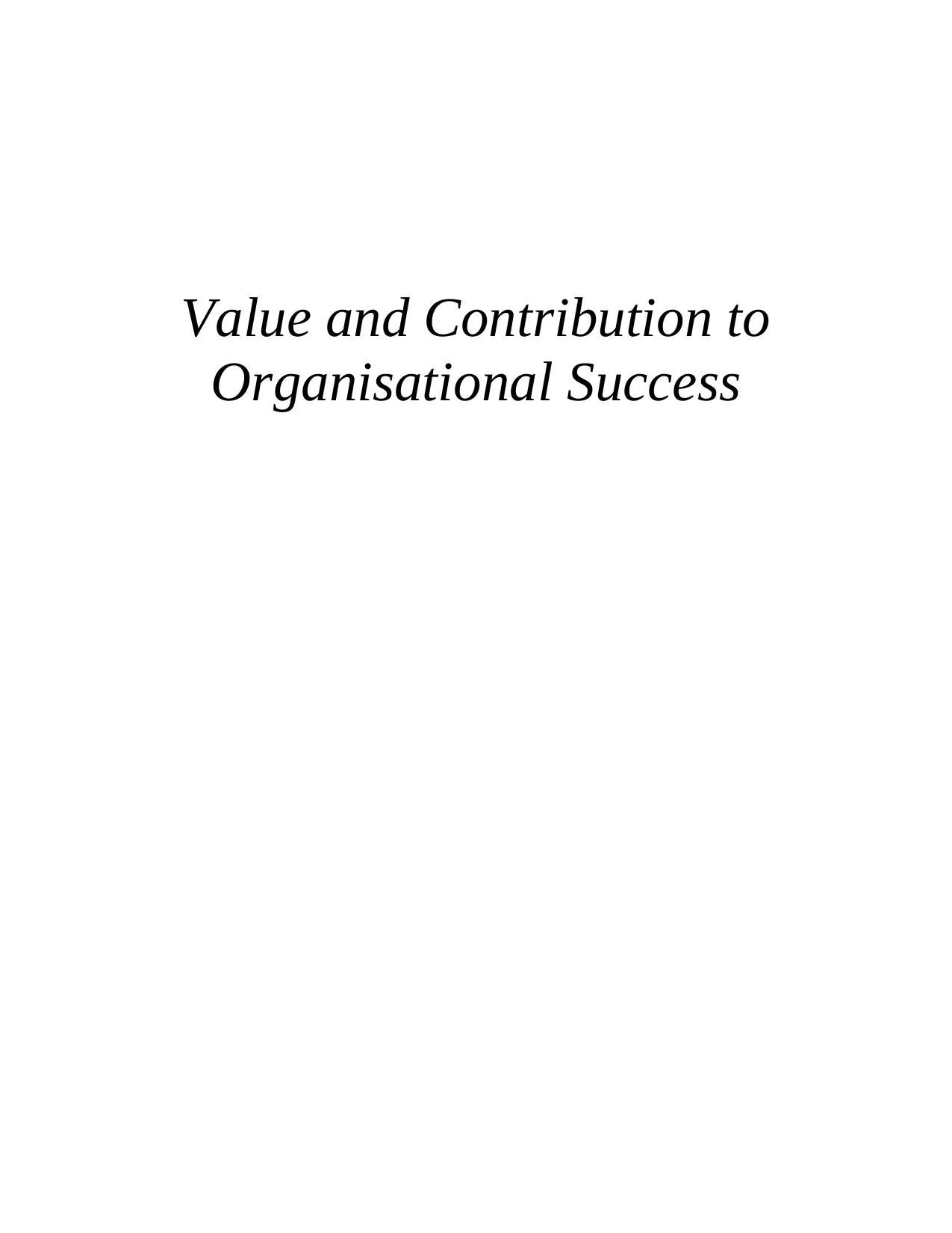
Value and Contribution to
Organisational Success
Organisational Success
Paraphrase This Document
Need a fresh take? Get an instant paraphrase of this document with our AI Paraphraser
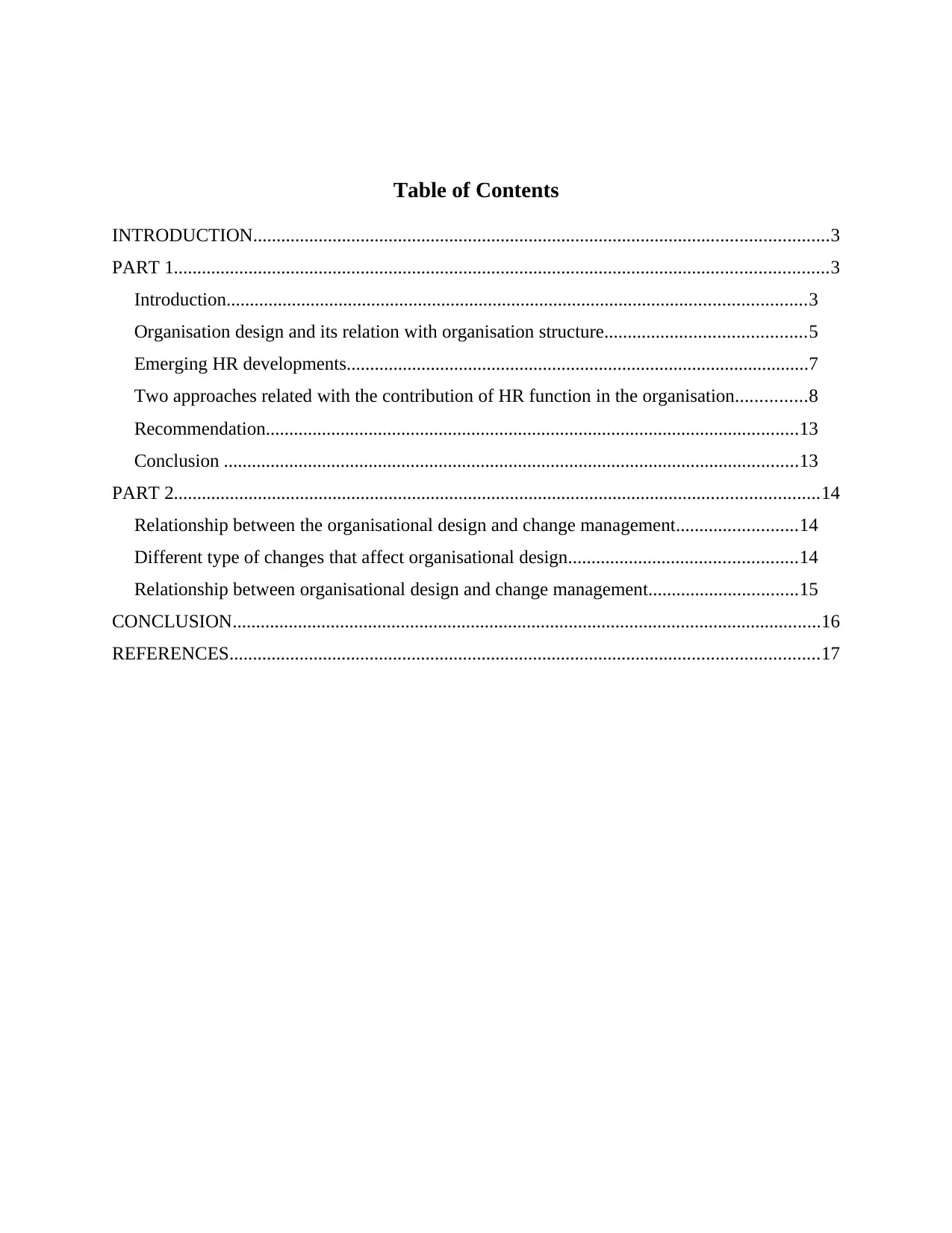
Table of Contents
INTRODUCTION...........................................................................................................................3
PART 1............................................................................................................................................3
Introduction............................................................................................................................3
Organisation design and its relation with organisation structure...........................................5
Emerging HR developments...................................................................................................7
Two approaches related with the contribution of HR function in the organisation...............8
Recommendation..................................................................................................................13
Conclusion ...........................................................................................................................13
PART 2..........................................................................................................................................14
Relationship between the organisational design and change management..........................14
Different type of changes that affect organisational design.................................................14
Relationship between organisational design and change management................................15
CONCLUSION..............................................................................................................................16
REFERENCES..............................................................................................................................17
INTRODUCTION...........................................................................................................................3
PART 1............................................................................................................................................3
Introduction............................................................................................................................3
Organisation design and its relation with organisation structure...........................................5
Emerging HR developments...................................................................................................7
Two approaches related with the contribution of HR function in the organisation...............8
Recommendation..................................................................................................................13
Conclusion ...........................................................................................................................13
PART 2..........................................................................................................................................14
Relationship between the organisational design and change management..........................14
Different type of changes that affect organisational design.................................................14
Relationship between organisational design and change management................................15
CONCLUSION..............................................................................................................................16
REFERENCES..............................................................................................................................17
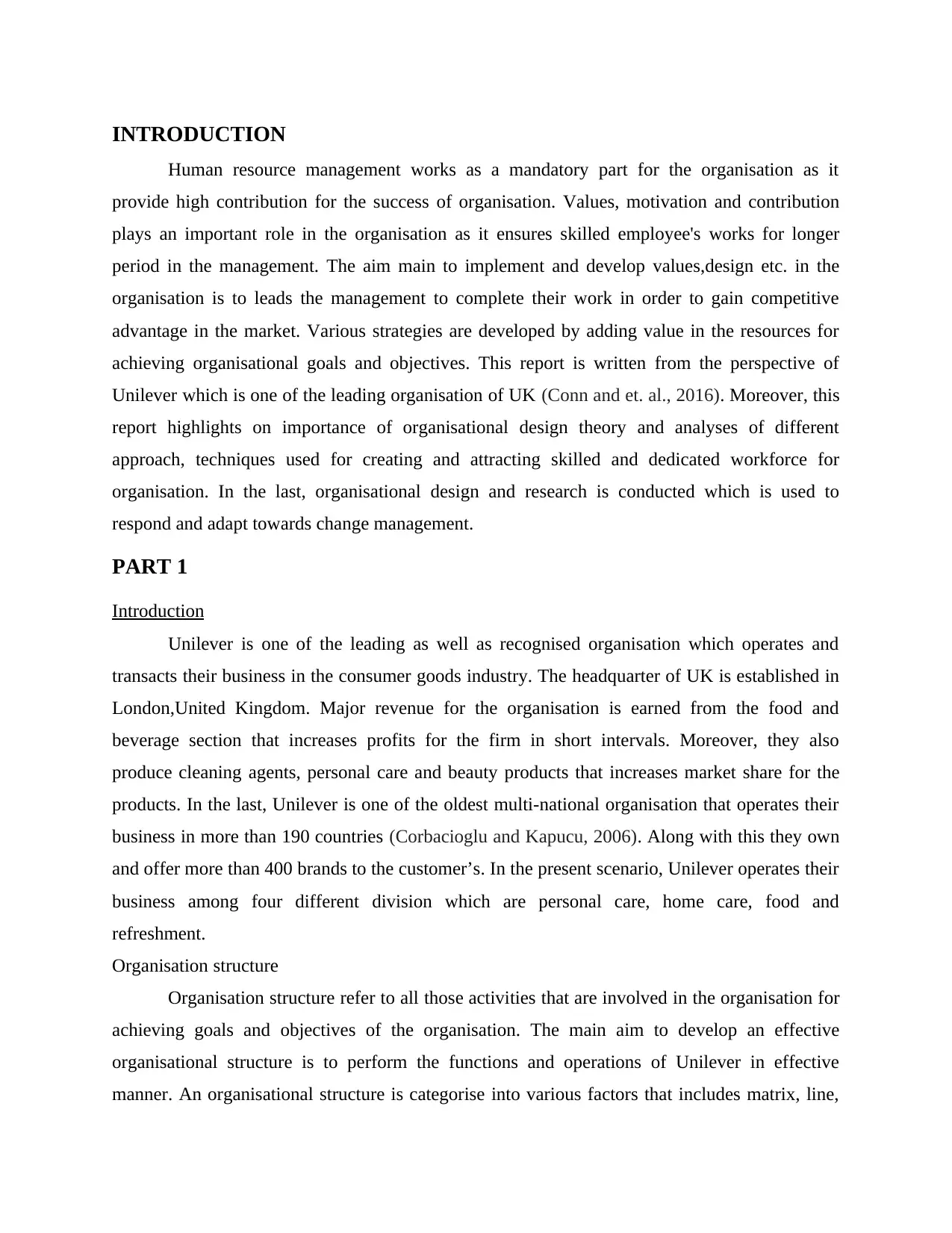
INTRODUCTION
Human resource management works as a mandatory part for the organisation as it
provide high contribution for the success of organisation. Values, motivation and contribution
plays an important role in the organisation as it ensures skilled employee's works for longer
period in the management. The aim main to implement and develop values,design etc. in the
organisation is to leads the management to complete their work in order to gain competitive
advantage in the market. Various strategies are developed by adding value in the resources for
achieving organisational goals and objectives. This report is written from the perspective of
Unilever which is one of the leading organisation of UK (Conn and et. al., 2016). Moreover, this
report highlights on importance of organisational design theory and analyses of different
approach, techniques used for creating and attracting skilled and dedicated workforce for
organisation. In the last, organisational design and research is conducted which is used to
respond and adapt towards change management.
PART 1
Introduction
Unilever is one of the leading as well as recognised organisation which operates and
transacts their business in the consumer goods industry. The headquarter of UK is established in
London,United Kingdom. Major revenue for the organisation is earned from the food and
beverage section that increases profits for the firm in short intervals. Moreover, they also
produce cleaning agents, personal care and beauty products that increases market share for the
products. In the last, Unilever is one of the oldest multi-national organisation that operates their
business in more than 190 countries (Corbacioglu and Kapucu, 2006). Along with this they own
and offer more than 400 brands to the customer’s. In the present scenario, Unilever operates their
business among four different division which are personal care, home care, food and
refreshment.
Organisation structure
Organisation structure refer to all those activities that are involved in the organisation for
achieving goals and objectives of the organisation. The main aim to develop an effective
organisational structure is to perform the functions and operations of Unilever in effective
manner. An organisational structure is categorise into various factors that includes matrix, line,
Human resource management works as a mandatory part for the organisation as it
provide high contribution for the success of organisation. Values, motivation and contribution
plays an important role in the organisation as it ensures skilled employee's works for longer
period in the management. The aim main to implement and develop values,design etc. in the
organisation is to leads the management to complete their work in order to gain competitive
advantage in the market. Various strategies are developed by adding value in the resources for
achieving organisational goals and objectives. This report is written from the perspective of
Unilever which is one of the leading organisation of UK (Conn and et. al., 2016). Moreover, this
report highlights on importance of organisational design theory and analyses of different
approach, techniques used for creating and attracting skilled and dedicated workforce for
organisation. In the last, organisational design and research is conducted which is used to
respond and adapt towards change management.
PART 1
Introduction
Unilever is one of the leading as well as recognised organisation which operates and
transacts their business in the consumer goods industry. The headquarter of UK is established in
London,United Kingdom. Major revenue for the organisation is earned from the food and
beverage section that increases profits for the firm in short intervals. Moreover, they also
produce cleaning agents, personal care and beauty products that increases market share for the
products. In the last, Unilever is one of the oldest multi-national organisation that operates their
business in more than 190 countries (Corbacioglu and Kapucu, 2006). Along with this they own
and offer more than 400 brands to the customer’s. In the present scenario, Unilever operates their
business among four different division which are personal care, home care, food and
refreshment.
Organisation structure
Organisation structure refer to all those activities that are involved in the organisation for
achieving goals and objectives of the organisation. The main aim to develop an effective
organisational structure is to perform the functions and operations of Unilever in effective
manner. An organisational structure is categorise into various factors that includes matrix, line,
⊘ This is a preview!⊘
Do you want full access?
Subscribe today to unlock all pages.

Trusted by 1+ million students worldwide
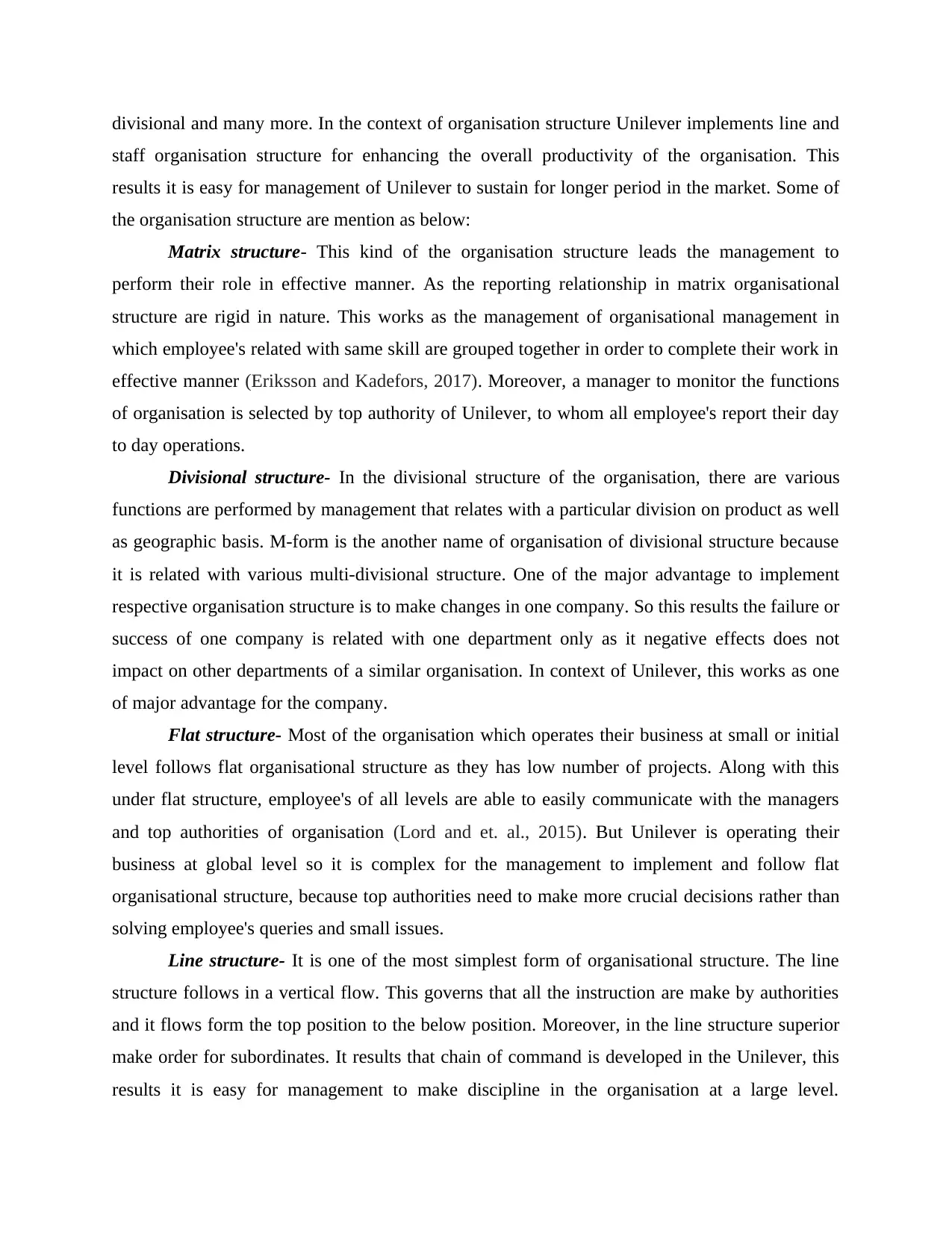
divisional and many more. In the context of organisation structure Unilever implements line and
staff organisation structure for enhancing the overall productivity of the organisation. This
results it is easy for management of Unilever to sustain for longer period in the market. Some of
the organisation structure are mention as below:
Matrix structure- This kind of the organisation structure leads the management to
perform their role in effective manner. As the reporting relationship in matrix organisational
structure are rigid in nature. This works as the management of organisational management in
which employee's related with same skill are grouped together in order to complete their work in
effective manner (Eriksson and Kadefors, 2017). Moreover, a manager to monitor the functions
of organisation is selected by top authority of Unilever, to whom all employee's report their day
to day operations.
Divisional structure- In the divisional structure of the organisation, there are various
functions are performed by management that relates with a particular division on product as well
as geographic basis. M-form is the another name of organisation of divisional structure because
it is related with various multi-divisional structure. One of the major advantage to implement
respective organisation structure is to make changes in one company. So this results the failure or
success of one company is related with one department only as it negative effects does not
impact on other departments of a similar organisation. In context of Unilever, this works as one
of major advantage for the company.
Flat structure- Most of the organisation which operates their business at small or initial
level follows flat organisational structure as they has low number of projects. Along with this
under flat structure, employee's of all levels are able to easily communicate with the managers
and top authorities of organisation (Lord and et. al., 2015). But Unilever is operating their
business at global level so it is complex for the management to implement and follow flat
organisational structure, because top authorities need to make more crucial decisions rather than
solving employee's queries and small issues.
Line structure- It is one of the most simplest form of organisational structure. The line
structure follows in a vertical flow. This governs that all the instruction are make by authorities
and it flows form the top position to the below position. Moreover, in the line structure superior
make order for subordinates. It results that chain of command is developed in the Unilever, this
results it is easy for management to make discipline in the organisation at a large level.
staff organisation structure for enhancing the overall productivity of the organisation. This
results it is easy for management of Unilever to sustain for longer period in the market. Some of
the organisation structure are mention as below:
Matrix structure- This kind of the organisation structure leads the management to
perform their role in effective manner. As the reporting relationship in matrix organisational
structure are rigid in nature. This works as the management of organisational management in
which employee's related with same skill are grouped together in order to complete their work in
effective manner (Eriksson and Kadefors, 2017). Moreover, a manager to monitor the functions
of organisation is selected by top authority of Unilever, to whom all employee's report their day
to day operations.
Divisional structure- In the divisional structure of the organisation, there are various
functions are performed by management that relates with a particular division on product as well
as geographic basis. M-form is the another name of organisation of divisional structure because
it is related with various multi-divisional structure. One of the major advantage to implement
respective organisation structure is to make changes in one company. So this results the failure or
success of one company is related with one department only as it negative effects does not
impact on other departments of a similar organisation. In context of Unilever, this works as one
of major advantage for the company.
Flat structure- Most of the organisation which operates their business at small or initial
level follows flat organisational structure as they has low number of projects. Along with this
under flat structure, employee's of all levels are able to easily communicate with the managers
and top authorities of organisation (Lord and et. al., 2015). But Unilever is operating their
business at global level so it is complex for the management to implement and follow flat
organisational structure, because top authorities need to make more crucial decisions rather than
solving employee's queries and small issues.
Line structure- It is one of the most simplest form of organisational structure. The line
structure follows in a vertical flow. This governs that all the instruction are make by authorities
and it flows form the top position to the below position. Moreover, in the line structure superior
make order for subordinates. It results that chain of command is developed in the Unilever, this
results it is easy for management to make discipline in the organisation at a large level.
Paraphrase This Document
Need a fresh take? Get an instant paraphrase of this document with our AI Paraphraser
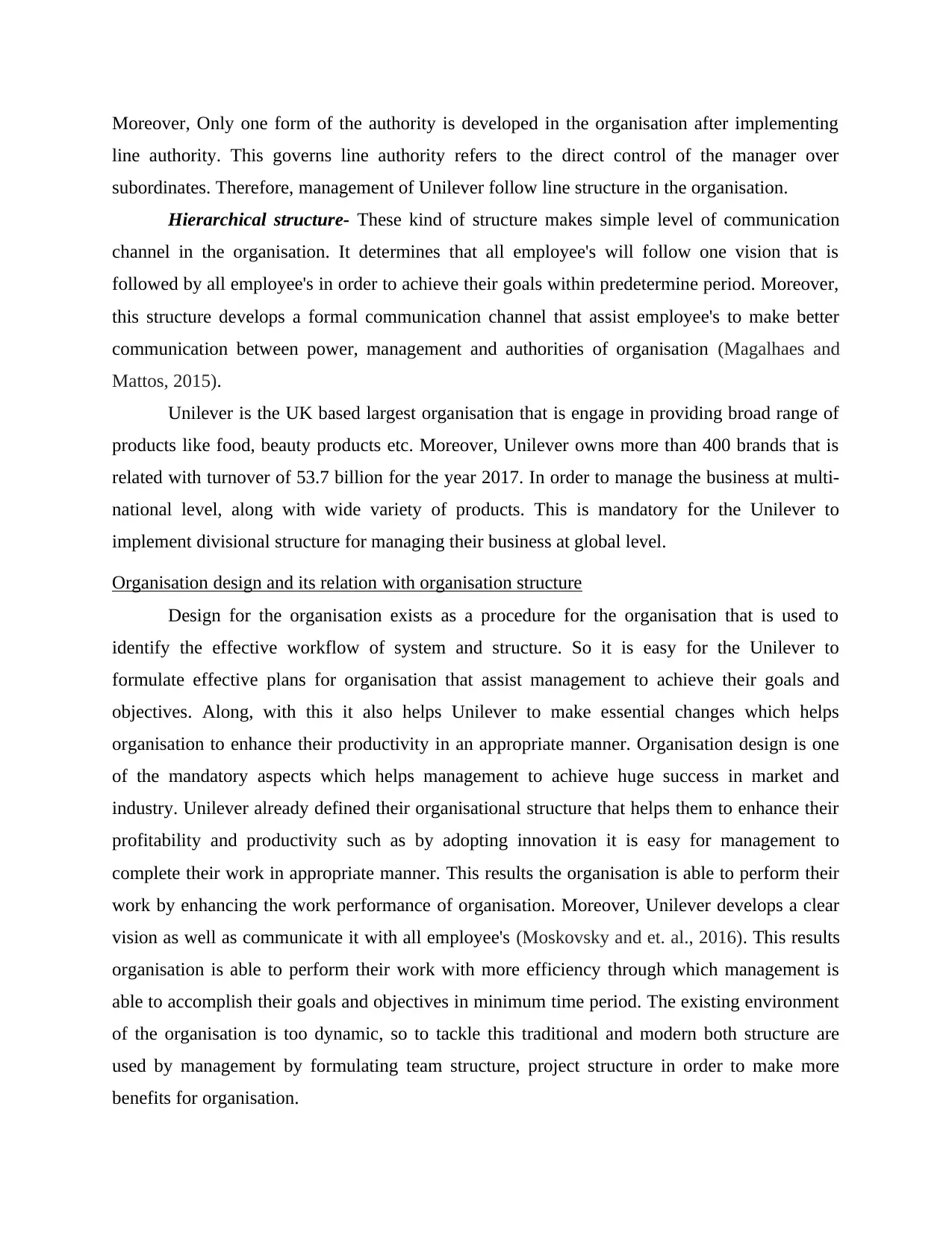
Moreover, Only one form of the authority is developed in the organisation after implementing
line authority. This governs line authority refers to the direct control of the manager over
subordinates. Therefore, management of Unilever follow line structure in the organisation.
Hierarchical structure- These kind of structure makes simple level of communication
channel in the organisation. It determines that all employee's will follow one vision that is
followed by all employee's in order to achieve their goals within predetermine period. Moreover,
this structure develops a formal communication channel that assist employee's to make better
communication between power, management and authorities of organisation (Magalhaes and
Mattos, 2015).
Unilever is the UK based largest organisation that is engage in providing broad range of
products like food, beauty products etc. Moreover, Unilever owns more than 400 brands that is
related with turnover of 53.7 billion for the year 2017. In order to manage the business at multi-
national level, along with wide variety of products. This is mandatory for the Unilever to
implement divisional structure for managing their business at global level.
Organisation design and its relation with organisation structure
Design for the organisation exists as a procedure for the organisation that is used to
identify the effective workflow of system and structure. So it is easy for the Unilever to
formulate effective plans for organisation that assist management to achieve their goals and
objectives. Along, with this it also helps Unilever to make essential changes which helps
organisation to enhance their productivity in an appropriate manner. Organisation design is one
of the mandatory aspects which helps management to achieve huge success in market and
industry. Unilever already defined their organisational structure that helps them to enhance their
profitability and productivity such as by adopting innovation it is easy for management to
complete their work in appropriate manner. This results the organisation is able to perform their
work by enhancing the work performance of organisation. Moreover, Unilever develops a clear
vision as well as communicate it with all employee's (Moskovsky and et. al., 2016). This results
organisation is able to perform their work with more efficiency through which management is
able to accomplish their goals and objectives in minimum time period. The existing environment
of the organisation is too dynamic, so to tackle this traditional and modern both structure are
used by management by formulating team structure, project structure in order to make more
benefits for organisation.
line authority. This governs line authority refers to the direct control of the manager over
subordinates. Therefore, management of Unilever follow line structure in the organisation.
Hierarchical structure- These kind of structure makes simple level of communication
channel in the organisation. It determines that all employee's will follow one vision that is
followed by all employee's in order to achieve their goals within predetermine period. Moreover,
this structure develops a formal communication channel that assist employee's to make better
communication between power, management and authorities of organisation (Magalhaes and
Mattos, 2015).
Unilever is the UK based largest organisation that is engage in providing broad range of
products like food, beauty products etc. Moreover, Unilever owns more than 400 brands that is
related with turnover of 53.7 billion for the year 2017. In order to manage the business at multi-
national level, along with wide variety of products. This is mandatory for the Unilever to
implement divisional structure for managing their business at global level.
Organisation design and its relation with organisation structure
Design for the organisation exists as a procedure for the organisation that is used to
identify the effective workflow of system and structure. So it is easy for the Unilever to
formulate effective plans for organisation that assist management to achieve their goals and
objectives. Along, with this it also helps Unilever to make essential changes which helps
organisation to enhance their productivity in an appropriate manner. Organisation design is one
of the mandatory aspects which helps management to achieve huge success in market and
industry. Unilever already defined their organisational structure that helps them to enhance their
profitability and productivity such as by adopting innovation it is easy for management to
complete their work in appropriate manner. This results the organisation is able to perform their
work by enhancing the work performance of organisation. Moreover, Unilever develops a clear
vision as well as communicate it with all employee's (Moskovsky and et. al., 2016). This results
organisation is able to perform their work with more efficiency through which management is
able to accomplish their goals and objectives in minimum time period. The existing environment
of the organisation is too dynamic, so to tackle this traditional and modern both structure are
used by management by formulating team structure, project structure in order to make more
benefits for organisation.
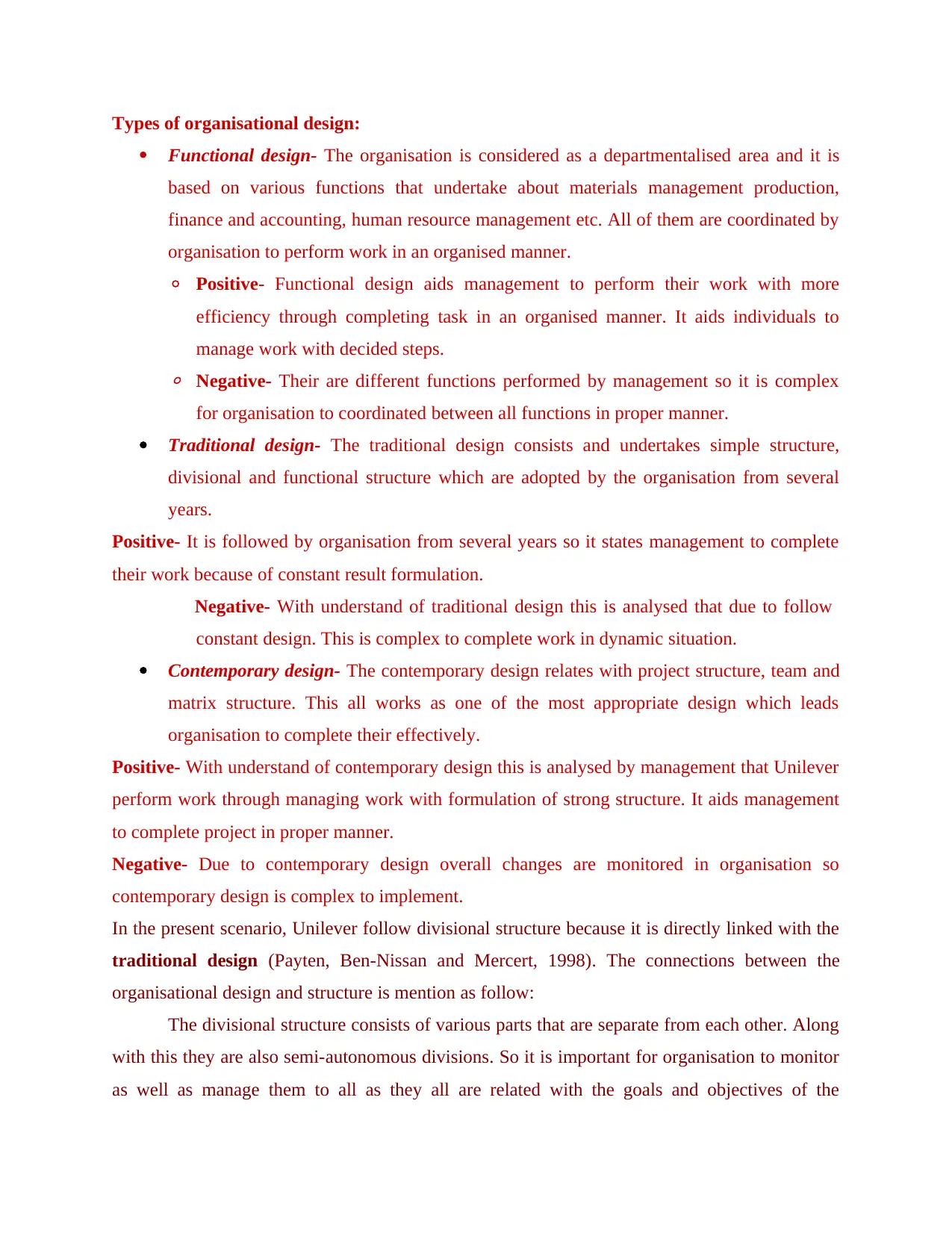
Types of organisational design:
Functional design- The organisation is considered as a departmentalised area and it is
based on various functions that undertake about materials management production,
finance and accounting, human resource management etc. All of them are coordinated by
organisation to perform work in an organised manner.
◦ Positive- Functional design aids management to perform their work with more
efficiency through completing task in an organised manner. It aids individuals to
manage work with decided steps.
◦ Negative- Their are different functions performed by management so it is complex
for organisation to coordinated between all functions in proper manner.
Traditional design- The traditional design consists and undertakes simple structure,
divisional and functional structure which are adopted by the organisation from several
years.
Positive- It is followed by organisation from several years so it states management to complete
their work because of constant result formulation.
Negative- With understand of traditional design this is analysed that due to follow
constant design. This is complex to complete work in dynamic situation.
Contemporary design- The contemporary design relates with project structure, team and
matrix structure. This all works as one of the most appropriate design which leads
organisation to complete their effectively.
Positive- With understand of contemporary design this is analysed by management that Unilever
perform work through managing work with formulation of strong structure. It aids management
to complete project in proper manner.
Negative- Due to contemporary design overall changes are monitored in organisation so
contemporary design is complex to implement.
In the present scenario, Unilever follow divisional structure because it is directly linked with the
traditional design (Payten, Ben-Nissan and Mercert, 1998). The connections between the
organisational design and structure is mention as follow:
The divisional structure consists of various parts that are separate from each other. Along
with this they are also semi-autonomous divisions. So it is important for organisation to monitor
as well as manage them to all as they all are related with the goals and objectives of the
Functional design- The organisation is considered as a departmentalised area and it is
based on various functions that undertake about materials management production,
finance and accounting, human resource management etc. All of them are coordinated by
organisation to perform work in an organised manner.
◦ Positive- Functional design aids management to perform their work with more
efficiency through completing task in an organised manner. It aids individuals to
manage work with decided steps.
◦ Negative- Their are different functions performed by management so it is complex
for organisation to coordinated between all functions in proper manner.
Traditional design- The traditional design consists and undertakes simple structure,
divisional and functional structure which are adopted by the organisation from several
years.
Positive- It is followed by organisation from several years so it states management to complete
their work because of constant result formulation.
Negative- With understand of traditional design this is analysed that due to follow
constant design. This is complex to complete work in dynamic situation.
Contemporary design- The contemporary design relates with project structure, team and
matrix structure. This all works as one of the most appropriate design which leads
organisation to complete their effectively.
Positive- With understand of contemporary design this is analysed by management that Unilever
perform work through managing work with formulation of strong structure. It aids management
to complete project in proper manner.
Negative- Due to contemporary design overall changes are monitored in organisation so
contemporary design is complex to implement.
In the present scenario, Unilever follow divisional structure because it is directly linked with the
traditional design (Payten, Ben-Nissan and Mercert, 1998). The connections between the
organisational design and structure is mention as follow:
The divisional structure consists of various parts that are separate from each other. Along
with this they are also semi-autonomous divisions. So it is important for organisation to monitor
as well as manage them to all as they all are related with the goals and objectives of the
⊘ This is a preview!⊘
Do you want full access?
Subscribe today to unlock all pages.

Trusted by 1+ million students worldwide
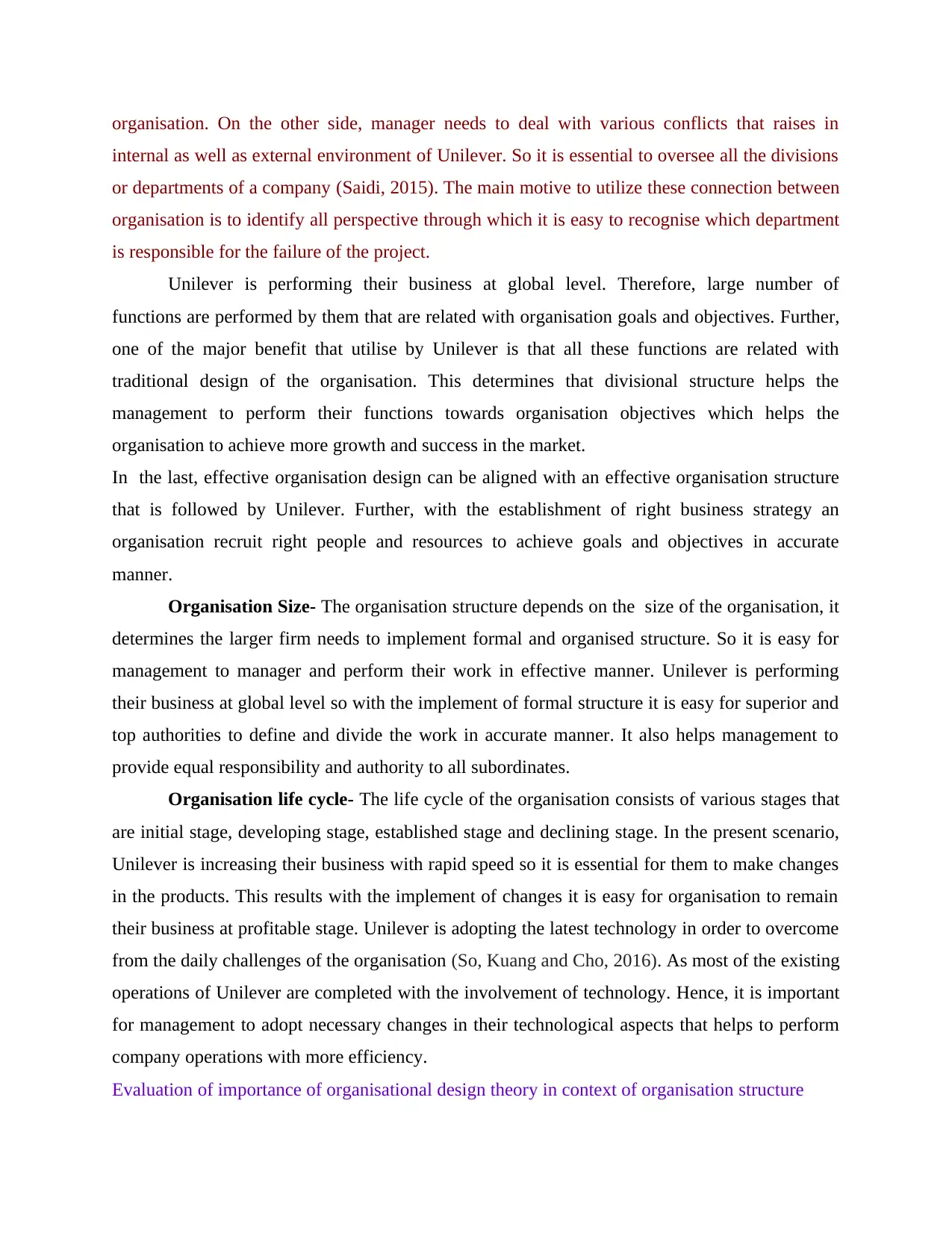
organisation. On the other side, manager needs to deal with various conflicts that raises in
internal as well as external environment of Unilever. So it is essential to oversee all the divisions
or departments of a company (Saidi, 2015). The main motive to utilize these connection between
organisation is to identify all perspective through which it is easy to recognise which department
is responsible for the failure of the project.
Unilever is performing their business at global level. Therefore, large number of
functions are performed by them that are related with organisation goals and objectives. Further,
one of the major benefit that utilise by Unilever is that all these functions are related with
traditional design of the organisation. This determines that divisional structure helps the
management to perform their functions towards organisation objectives which helps the
organisation to achieve more growth and success in the market.
In the last, effective organisation design can be aligned with an effective organisation structure
that is followed by Unilever. Further, with the establishment of right business strategy an
organisation recruit right people and resources to achieve goals and objectives in accurate
manner.
Organisation Size- The organisation structure depends on the size of the organisation, it
determines the larger firm needs to implement formal and organised structure. So it is easy for
management to manager and perform their work in effective manner. Unilever is performing
their business at global level so with the implement of formal structure it is easy for superior and
top authorities to define and divide the work in accurate manner. It also helps management to
provide equal responsibility and authority to all subordinates.
Organisation life cycle- The life cycle of the organisation consists of various stages that
are initial stage, developing stage, established stage and declining stage. In the present scenario,
Unilever is increasing their business with rapid speed so it is essential for them to make changes
in the products. This results with the implement of changes it is easy for organisation to remain
their business at profitable stage. Unilever is adopting the latest technology in order to overcome
from the daily challenges of the organisation (So, Kuang and Cho, 2016). As most of the existing
operations of Unilever are completed with the involvement of technology. Hence, it is important
for management to adopt necessary changes in their technological aspects that helps to perform
company operations with more efficiency.
Evaluation of importance of organisational design theory in context of organisation structure
internal as well as external environment of Unilever. So it is essential to oversee all the divisions
or departments of a company (Saidi, 2015). The main motive to utilize these connection between
organisation is to identify all perspective through which it is easy to recognise which department
is responsible for the failure of the project.
Unilever is performing their business at global level. Therefore, large number of
functions are performed by them that are related with organisation goals and objectives. Further,
one of the major benefit that utilise by Unilever is that all these functions are related with
traditional design of the organisation. This determines that divisional structure helps the
management to perform their functions towards organisation objectives which helps the
organisation to achieve more growth and success in the market.
In the last, effective organisation design can be aligned with an effective organisation structure
that is followed by Unilever. Further, with the establishment of right business strategy an
organisation recruit right people and resources to achieve goals and objectives in accurate
manner.
Organisation Size- The organisation structure depends on the size of the organisation, it
determines the larger firm needs to implement formal and organised structure. So it is easy for
management to manager and perform their work in effective manner. Unilever is performing
their business at global level so with the implement of formal structure it is easy for superior and
top authorities to define and divide the work in accurate manner. It also helps management to
provide equal responsibility and authority to all subordinates.
Organisation life cycle- The life cycle of the organisation consists of various stages that
are initial stage, developing stage, established stage and declining stage. In the present scenario,
Unilever is increasing their business with rapid speed so it is essential for them to make changes
in the products. This results with the implement of changes it is easy for organisation to remain
their business at profitable stage. Unilever is adopting the latest technology in order to overcome
from the daily challenges of the organisation (So, Kuang and Cho, 2016). As most of the existing
operations of Unilever are completed with the involvement of technology. Hence, it is important
for management to adopt necessary changes in their technological aspects that helps to perform
company operations with more efficiency.
Evaluation of importance of organisational design theory in context of organisation structure
Paraphrase This Document
Need a fresh take? Get an instant paraphrase of this document with our AI Paraphraser
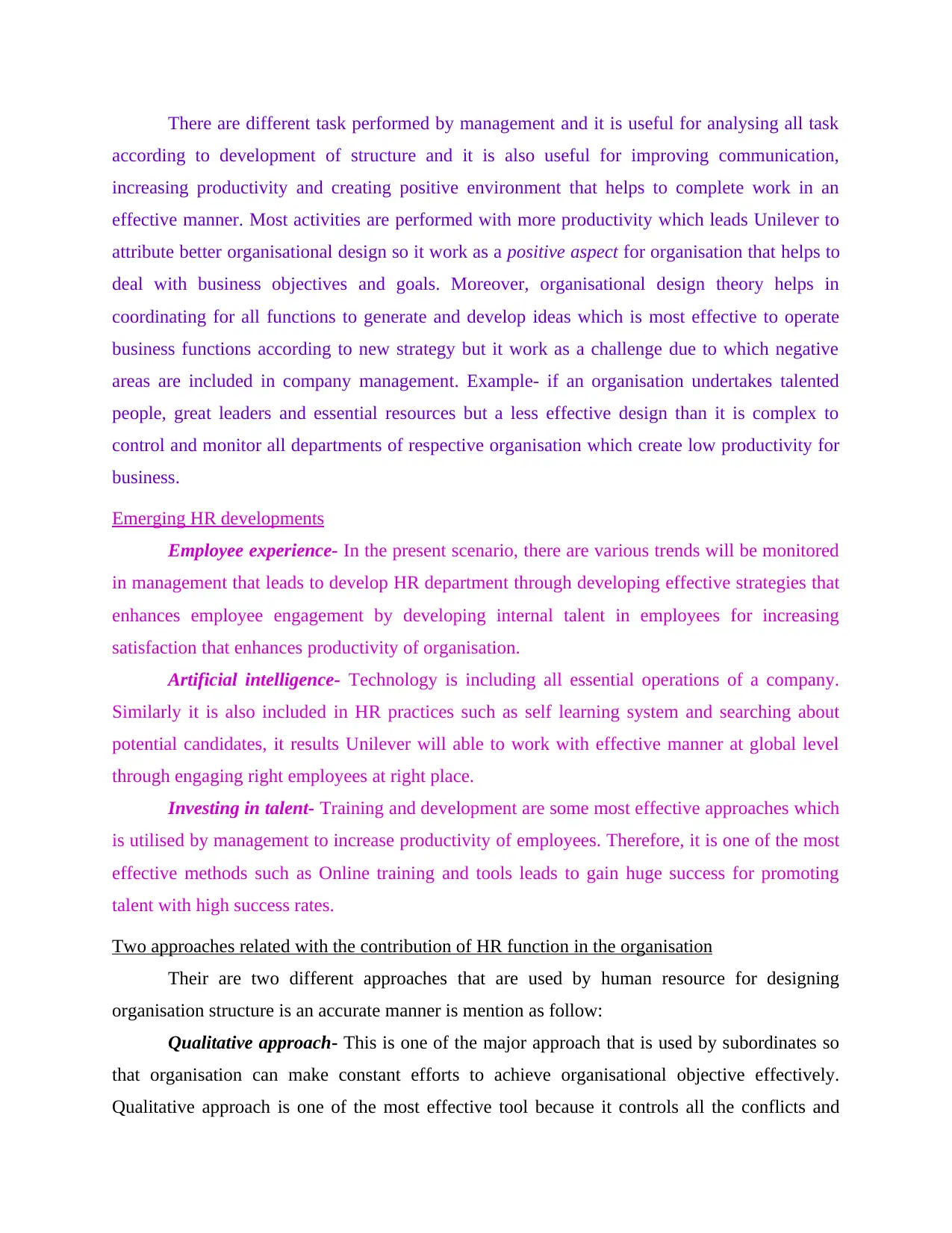
There are different task performed by management and it is useful for analysing all task
according to development of structure and it is also useful for improving communication,
increasing productivity and creating positive environment that helps to complete work in an
effective manner. Most activities are performed with more productivity which leads Unilever to
attribute better organisational design so it work as a positive aspect for organisation that helps to
deal with business objectives and goals. Moreover, organisational design theory helps in
coordinating for all functions to generate and develop ideas which is most effective to operate
business functions according to new strategy but it work as a challenge due to which negative
areas are included in company management. Example- if an organisation undertakes talented
people, great leaders and essential resources but a less effective design than it is complex to
control and monitor all departments of respective organisation which create low productivity for
business.
Emerging HR developments
Employee experience- In the present scenario, there are various trends will be monitored
in management that leads to develop HR department through developing effective strategies that
enhances employee engagement by developing internal talent in employees for increasing
satisfaction that enhances productivity of organisation.
Artificial intelligence- Technology is including all essential operations of a company.
Similarly it is also included in HR practices such as self learning system and searching about
potential candidates, it results Unilever will able to work with effective manner at global level
through engaging right employees at right place.
Investing in talent- Training and development are some most effective approaches which
is utilised by management to increase productivity of employees. Therefore, it is one of the most
effective methods such as Online training and tools leads to gain huge success for promoting
talent with high success rates.
Two approaches related with the contribution of HR function in the organisation
Their are two different approaches that are used by human resource for designing
organisation structure is an accurate manner is mention as follow:
Qualitative approach- This is one of the major approach that is used by subordinates so
that organisation can make constant efforts to achieve organisational objective effectively.
Qualitative approach is one of the most effective tool because it controls all the conflicts and
according to development of structure and it is also useful for improving communication,
increasing productivity and creating positive environment that helps to complete work in an
effective manner. Most activities are performed with more productivity which leads Unilever to
attribute better organisational design so it work as a positive aspect for organisation that helps to
deal with business objectives and goals. Moreover, organisational design theory helps in
coordinating for all functions to generate and develop ideas which is most effective to operate
business functions according to new strategy but it work as a challenge due to which negative
areas are included in company management. Example- if an organisation undertakes talented
people, great leaders and essential resources but a less effective design than it is complex to
control and monitor all departments of respective organisation which create low productivity for
business.
Emerging HR developments
Employee experience- In the present scenario, there are various trends will be monitored
in management that leads to develop HR department through developing effective strategies that
enhances employee engagement by developing internal talent in employees for increasing
satisfaction that enhances productivity of organisation.
Artificial intelligence- Technology is including all essential operations of a company.
Similarly it is also included in HR practices such as self learning system and searching about
potential candidates, it results Unilever will able to work with effective manner at global level
through engaging right employees at right place.
Investing in talent- Training and development are some most effective approaches which
is utilised by management to increase productivity of employees. Therefore, it is one of the most
effective methods such as Online training and tools leads to gain huge success for promoting
talent with high success rates.
Two approaches related with the contribution of HR function in the organisation
Their are two different approaches that are used by human resource for designing
organisation structure is an accurate manner is mention as follow:
Qualitative approach- This is one of the major approach that is used by subordinates so
that organisation can make constant efforts to achieve organisational objective effectively.
Qualitative approach is one of the most effective tool because it controls all the conflicts and
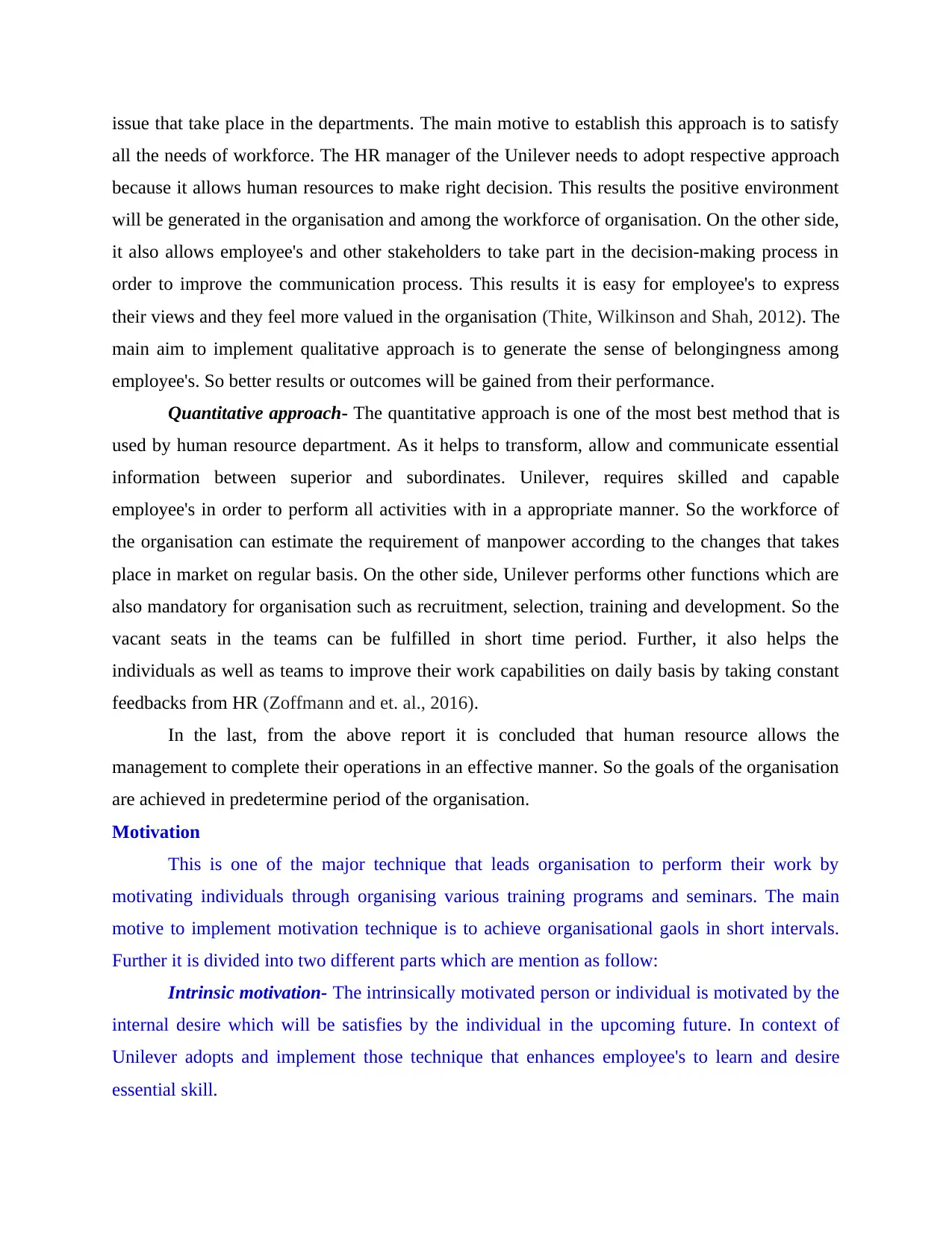
issue that take place in the departments. The main motive to establish this approach is to satisfy
all the needs of workforce. The HR manager of the Unilever needs to adopt respective approach
because it allows human resources to make right decision. This results the positive environment
will be generated in the organisation and among the workforce of organisation. On the other side,
it also allows employee's and other stakeholders to take part in the decision-making process in
order to improve the communication process. This results it is easy for employee's to express
their views and they feel more valued in the organisation (Thite, Wilkinson and Shah, 2012). The
main aim to implement qualitative approach is to generate the sense of belongingness among
employee's. So better results or outcomes will be gained from their performance.
Quantitative approach- The quantitative approach is one of the most best method that is
used by human resource department. As it helps to transform, allow and communicate essential
information between superior and subordinates. Unilever, requires skilled and capable
employee's in order to perform all activities with in a appropriate manner. So the workforce of
the organisation can estimate the requirement of manpower according to the changes that takes
place in market on regular basis. On the other side, Unilever performs other functions which are
also mandatory for organisation such as recruitment, selection, training and development. So the
vacant seats in the teams can be fulfilled in short time period. Further, it also helps the
individuals as well as teams to improve their work capabilities on daily basis by taking constant
feedbacks from HR (Zoffmann and et. al., 2016).
In the last, from the above report it is concluded that human resource allows the
management to complete their operations in an effective manner. So the goals of the organisation
are achieved in predetermine period of the organisation.
Motivation
This is one of the major technique that leads organisation to perform their work by
motivating individuals through organising various training programs and seminars. The main
motive to implement motivation technique is to achieve organisational gaols in short intervals.
Further it is divided into two different parts which are mention as follow:
Intrinsic motivation- The intrinsically motivated person or individual is motivated by the
internal desire which will be satisfies by the individual in the upcoming future. In context of
Unilever adopts and implement those technique that enhances employee's to learn and desire
essential skill.
all the needs of workforce. The HR manager of the Unilever needs to adopt respective approach
because it allows human resources to make right decision. This results the positive environment
will be generated in the organisation and among the workforce of organisation. On the other side,
it also allows employee's and other stakeholders to take part in the decision-making process in
order to improve the communication process. This results it is easy for employee's to express
their views and they feel more valued in the organisation (Thite, Wilkinson and Shah, 2012). The
main aim to implement qualitative approach is to generate the sense of belongingness among
employee's. So better results or outcomes will be gained from their performance.
Quantitative approach- The quantitative approach is one of the most best method that is
used by human resource department. As it helps to transform, allow and communicate essential
information between superior and subordinates. Unilever, requires skilled and capable
employee's in order to perform all activities with in a appropriate manner. So the workforce of
the organisation can estimate the requirement of manpower according to the changes that takes
place in market on regular basis. On the other side, Unilever performs other functions which are
also mandatory for organisation such as recruitment, selection, training and development. So the
vacant seats in the teams can be fulfilled in short time period. Further, it also helps the
individuals as well as teams to improve their work capabilities on daily basis by taking constant
feedbacks from HR (Zoffmann and et. al., 2016).
In the last, from the above report it is concluded that human resource allows the
management to complete their operations in an effective manner. So the goals of the organisation
are achieved in predetermine period of the organisation.
Motivation
This is one of the major technique that leads organisation to perform their work by
motivating individuals through organising various training programs and seminars. The main
motive to implement motivation technique is to achieve organisational gaols in short intervals.
Further it is divided into two different parts which are mention as follow:
Intrinsic motivation- The intrinsically motivated person or individual is motivated by the
internal desire which will be satisfies by the individual in the upcoming future. In context of
Unilever adopts and implement those technique that enhances employee's to learn and desire
essential skill.
⊘ This is a preview!⊘
Do you want full access?
Subscribe today to unlock all pages.

Trusted by 1+ million students worldwide
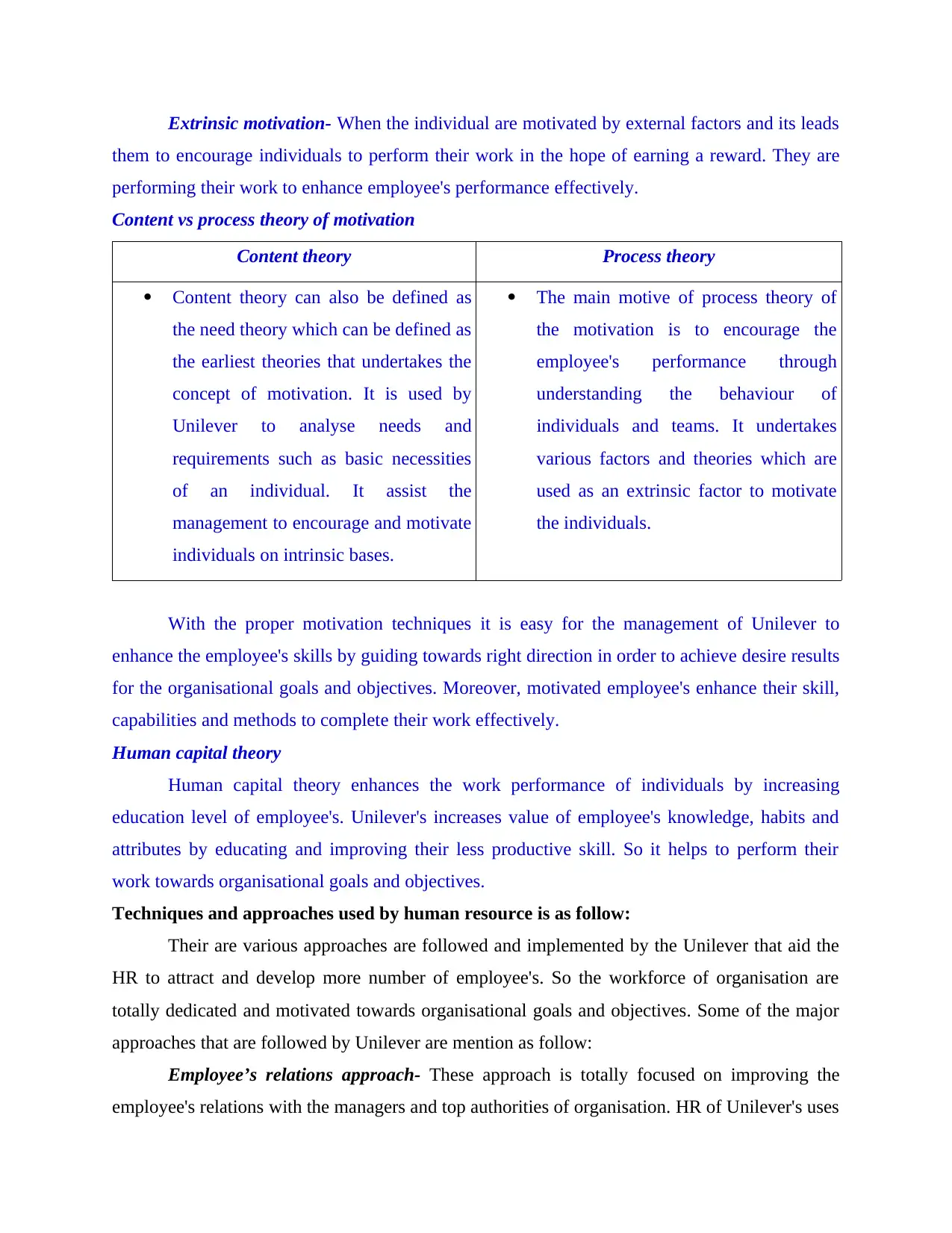
Extrinsic motivation- When the individual are motivated by external factors and its leads
them to encourage individuals to perform their work in the hope of earning a reward. They are
performing their work to enhance employee's performance effectively.
Content vs process theory of motivation
Content theory Process theory
Content theory can also be defined as
the need theory which can be defined as
the earliest theories that undertakes the
concept of motivation. It is used by
Unilever to analyse needs and
requirements such as basic necessities
of an individual. It assist the
management to encourage and motivate
individuals on intrinsic bases.
The main motive of process theory of
the motivation is to encourage the
employee's performance through
understanding the behaviour of
individuals and teams. It undertakes
various factors and theories which are
used as an extrinsic factor to motivate
the individuals.
With the proper motivation techniques it is easy for the management of Unilever to
enhance the employee's skills by guiding towards right direction in order to achieve desire results
for the organisational goals and objectives. Moreover, motivated employee's enhance their skill,
capabilities and methods to complete their work effectively.
Human capital theory
Human capital theory enhances the work performance of individuals by increasing
education level of employee's. Unilever's increases value of employee's knowledge, habits and
attributes by educating and improving their less productive skill. So it helps to perform their
work towards organisational goals and objectives.
Techniques and approaches used by human resource is as follow:
Their are various approaches are followed and implemented by the Unilever that aid the
HR to attract and develop more number of employee's. So the workforce of organisation are
totally dedicated and motivated towards organisational goals and objectives. Some of the major
approaches that are followed by Unilever are mention as follow:
Employee’s relations approach- These approach is totally focused on improving the
employee's relations with the managers and top authorities of organisation. HR of Unilever's uses
them to encourage individuals to perform their work in the hope of earning a reward. They are
performing their work to enhance employee's performance effectively.
Content vs process theory of motivation
Content theory Process theory
Content theory can also be defined as
the need theory which can be defined as
the earliest theories that undertakes the
concept of motivation. It is used by
Unilever to analyse needs and
requirements such as basic necessities
of an individual. It assist the
management to encourage and motivate
individuals on intrinsic bases.
The main motive of process theory of
the motivation is to encourage the
employee's performance through
understanding the behaviour of
individuals and teams. It undertakes
various factors and theories which are
used as an extrinsic factor to motivate
the individuals.
With the proper motivation techniques it is easy for the management of Unilever to
enhance the employee's skills by guiding towards right direction in order to achieve desire results
for the organisational goals and objectives. Moreover, motivated employee's enhance their skill,
capabilities and methods to complete their work effectively.
Human capital theory
Human capital theory enhances the work performance of individuals by increasing
education level of employee's. Unilever's increases value of employee's knowledge, habits and
attributes by educating and improving their less productive skill. So it helps to perform their
work towards organisational goals and objectives.
Techniques and approaches used by human resource is as follow:
Their are various approaches are followed and implemented by the Unilever that aid the
HR to attract and develop more number of employee's. So the workforce of organisation are
totally dedicated and motivated towards organisational goals and objectives. Some of the major
approaches that are followed by Unilever are mention as follow:
Employee’s relations approach- These approach is totally focused on improving the
employee's relations with the managers and top authorities of organisation. HR of Unilever's uses
Paraphrase This Document
Need a fresh take? Get an instant paraphrase of this document with our AI Paraphraser
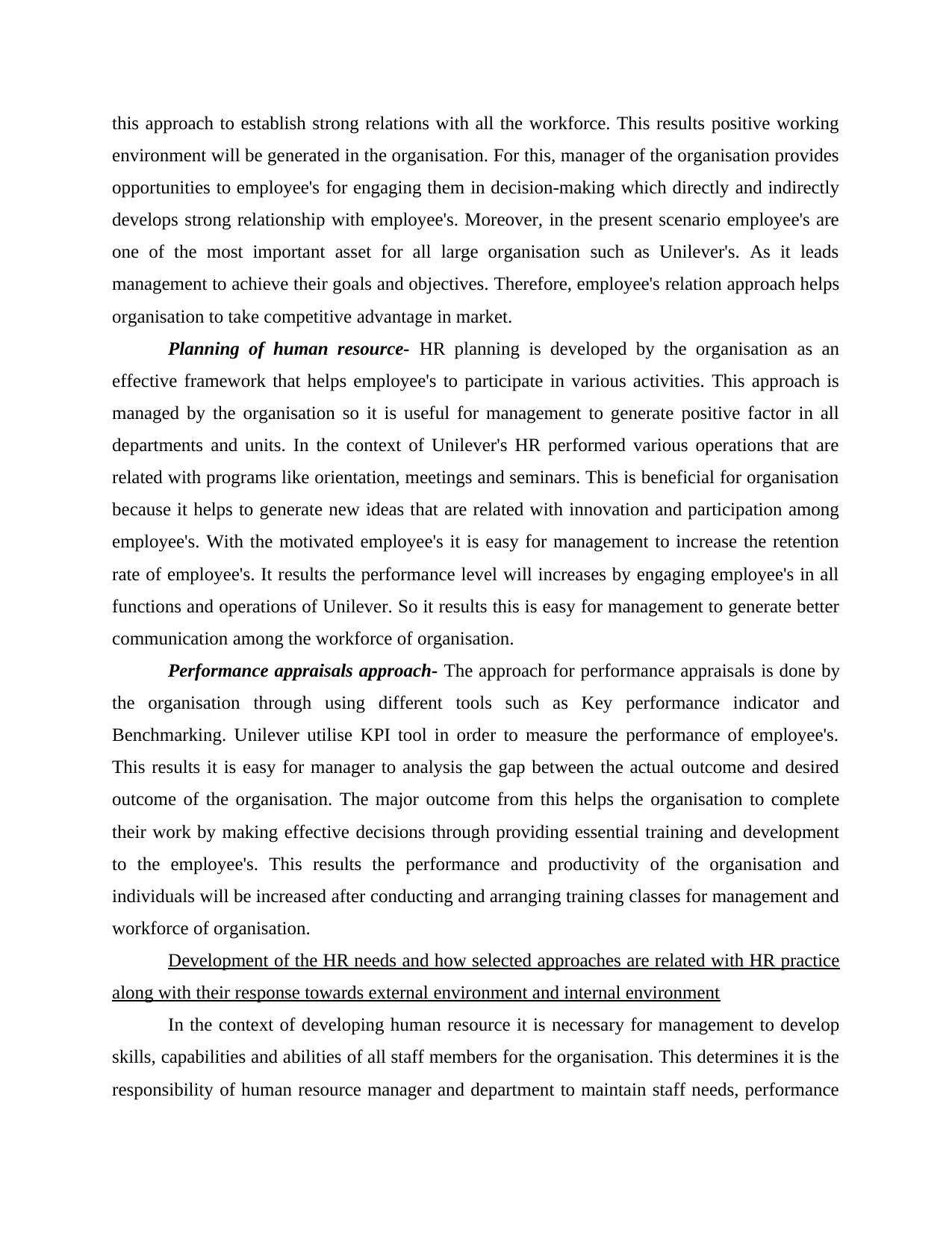
this approach to establish strong relations with all the workforce. This results positive working
environment will be generated in the organisation. For this, manager of the organisation provides
opportunities to employee's for engaging them in decision-making which directly and indirectly
develops strong relationship with employee's. Moreover, in the present scenario employee's are
one of the most important asset for all large organisation such as Unilever's. As it leads
management to achieve their goals and objectives. Therefore, employee's relation approach helps
organisation to take competitive advantage in market.
Planning of human resource- HR planning is developed by the organisation as an
effective framework that helps employee's to participate in various activities. This approach is
managed by the organisation so it is useful for management to generate positive factor in all
departments and units. In the context of Unilever's HR performed various operations that are
related with programs like orientation, meetings and seminars. This is beneficial for organisation
because it helps to generate new ideas that are related with innovation and participation among
employee's. With the motivated employee's it is easy for management to increase the retention
rate of employee's. It results the performance level will increases by engaging employee's in all
functions and operations of Unilever. So it results this is easy for management to generate better
communication among the workforce of organisation.
Performance appraisals approach- The approach for performance appraisals is done by
the organisation through using different tools such as Key performance indicator and
Benchmarking. Unilever utilise KPI tool in order to measure the performance of employee's.
This results it is easy for manager to analysis the gap between the actual outcome and desired
outcome of the organisation. The major outcome from this helps the organisation to complete
their work by making effective decisions through providing essential training and development
to the employee's. This results the performance and productivity of the organisation and
individuals will be increased after conducting and arranging training classes for management and
workforce of organisation.
Development of the HR needs and how selected approaches are related with HR practice
along with their response towards external environment and internal environment
In the context of developing human resource it is necessary for management to develop
skills, capabilities and abilities of all staff members for the organisation. This determines it is the
responsibility of human resource manager and department to maintain staff needs, performance
environment will be generated in the organisation. For this, manager of the organisation provides
opportunities to employee's for engaging them in decision-making which directly and indirectly
develops strong relationship with employee's. Moreover, in the present scenario employee's are
one of the most important asset for all large organisation such as Unilever's. As it leads
management to achieve their goals and objectives. Therefore, employee's relation approach helps
organisation to take competitive advantage in market.
Planning of human resource- HR planning is developed by the organisation as an
effective framework that helps employee's to participate in various activities. This approach is
managed by the organisation so it is useful for management to generate positive factor in all
departments and units. In the context of Unilever's HR performed various operations that are
related with programs like orientation, meetings and seminars. This is beneficial for organisation
because it helps to generate new ideas that are related with innovation and participation among
employee's. With the motivated employee's it is easy for management to increase the retention
rate of employee's. It results the performance level will increases by engaging employee's in all
functions and operations of Unilever. So it results this is easy for management to generate better
communication among the workforce of organisation.
Performance appraisals approach- The approach for performance appraisals is done by
the organisation through using different tools such as Key performance indicator and
Benchmarking. Unilever utilise KPI tool in order to measure the performance of employee's.
This results it is easy for manager to analysis the gap between the actual outcome and desired
outcome of the organisation. The major outcome from this helps the organisation to complete
their work by making effective decisions through providing essential training and development
to the employee's. This results the performance and productivity of the organisation and
individuals will be increased after conducting and arranging training classes for management and
workforce of organisation.
Development of the HR needs and how selected approaches are related with HR practice
along with their response towards external environment and internal environment
In the context of developing human resource it is necessary for management to develop
skills, capabilities and abilities of all staff members for the organisation. This determines it is the
responsibility of human resource manager and department to maintain staff needs, performance
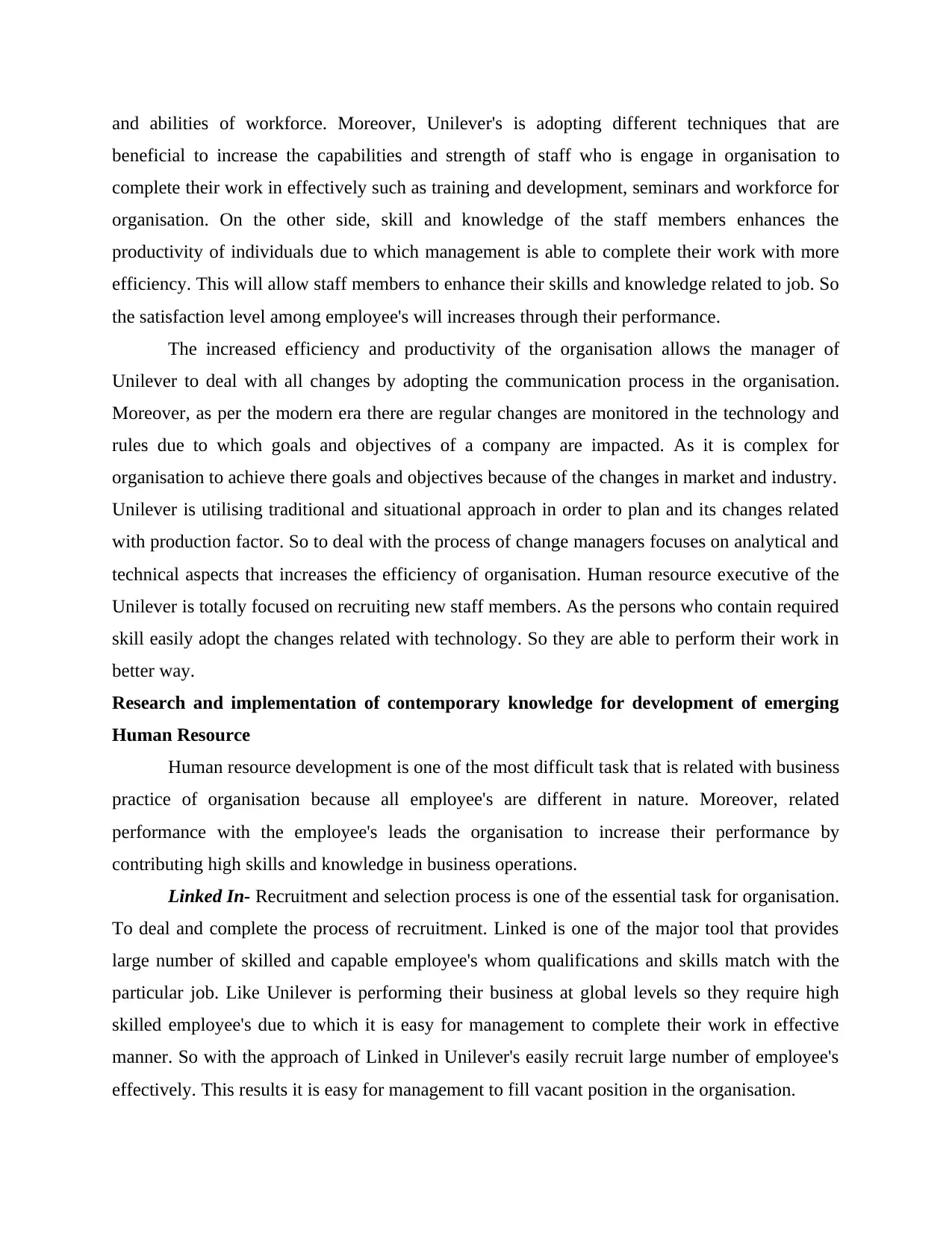
and abilities of workforce. Moreover, Unilever's is adopting different techniques that are
beneficial to increase the capabilities and strength of staff who is engage in organisation to
complete their work in effectively such as training and development, seminars and workforce for
organisation. On the other side, skill and knowledge of the staff members enhances the
productivity of individuals due to which management is able to complete their work with more
efficiency. This will allow staff members to enhance their skills and knowledge related to job. So
the satisfaction level among employee's will increases through their performance.
The increased efficiency and productivity of the organisation allows the manager of
Unilever to deal with all changes by adopting the communication process in the organisation.
Moreover, as per the modern era there are regular changes are monitored in the technology and
rules due to which goals and objectives of a company are impacted. As it is complex for
organisation to achieve there goals and objectives because of the changes in market and industry.
Unilever is utilising traditional and situational approach in order to plan and its changes related
with production factor. So to deal with the process of change managers focuses on analytical and
technical aspects that increases the efficiency of organisation. Human resource executive of the
Unilever is totally focused on recruiting new staff members. As the persons who contain required
skill easily adopt the changes related with technology. So they are able to perform their work in
better way.
Research and implementation of contemporary knowledge for development of emerging
Human Resource
Human resource development is one of the most difficult task that is related with business
practice of organisation because all employee's are different in nature. Moreover, related
performance with the employee's leads the organisation to increase their performance by
contributing high skills and knowledge in business operations.
Linked In- Recruitment and selection process is one of the essential task for organisation.
To deal and complete the process of recruitment. Linked is one of the major tool that provides
large number of skilled and capable employee's whom qualifications and skills match with the
particular job. Like Unilever is performing their business at global levels so they require high
skilled employee's due to which it is easy for management to complete their work in effective
manner. So with the approach of Linked in Unilever's easily recruit large number of employee's
effectively. This results it is easy for management to fill vacant position in the organisation.
beneficial to increase the capabilities and strength of staff who is engage in organisation to
complete their work in effectively such as training and development, seminars and workforce for
organisation. On the other side, skill and knowledge of the staff members enhances the
productivity of individuals due to which management is able to complete their work with more
efficiency. This will allow staff members to enhance their skills and knowledge related to job. So
the satisfaction level among employee's will increases through their performance.
The increased efficiency and productivity of the organisation allows the manager of
Unilever to deal with all changes by adopting the communication process in the organisation.
Moreover, as per the modern era there are regular changes are monitored in the technology and
rules due to which goals and objectives of a company are impacted. As it is complex for
organisation to achieve there goals and objectives because of the changes in market and industry.
Unilever is utilising traditional and situational approach in order to plan and its changes related
with production factor. So to deal with the process of change managers focuses on analytical and
technical aspects that increases the efficiency of organisation. Human resource executive of the
Unilever is totally focused on recruiting new staff members. As the persons who contain required
skill easily adopt the changes related with technology. So they are able to perform their work in
better way.
Research and implementation of contemporary knowledge for development of emerging
Human Resource
Human resource development is one of the most difficult task that is related with business
practice of organisation because all employee's are different in nature. Moreover, related
performance with the employee's leads the organisation to increase their performance by
contributing high skills and knowledge in business operations.
Linked In- Recruitment and selection process is one of the essential task for organisation.
To deal and complete the process of recruitment. Linked is one of the major tool that provides
large number of skilled and capable employee's whom qualifications and skills match with the
particular job. Like Unilever is performing their business at global levels so they require high
skilled employee's due to which it is easy for management to complete their work in effective
manner. So with the approach of Linked in Unilever's easily recruit large number of employee's
effectively. This results it is easy for management to fill vacant position in the organisation.
⊘ This is a preview!⊘
Do you want full access?
Subscribe today to unlock all pages.

Trusted by 1+ million students worldwide
1 out of 18
Related Documents
Your All-in-One AI-Powered Toolkit for Academic Success.
+13062052269
info@desklib.com
Available 24*7 on WhatsApp / Email
![[object Object]](/_next/static/media/star-bottom.7253800d.svg)
Unlock your academic potential
Copyright © 2020–2025 A2Z Services. All Rights Reserved. Developed and managed by ZUCOL.




